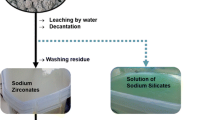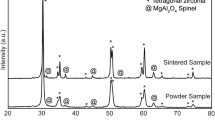Abstract
We present a novel low-temperature sol-solvothermal method to synthesize fine lead zirconate titanate (PZT) particles. This sol-solvothermal method combines the advantages of conventional sol–gel process and the solvothermal method, and isopropyl alcohol (IPA) was used as the solvent. The effects of different parameters including KOH concentration, IPA/(IPA + water) ratio and reaction temperature, on the microstructures of the PZT powder were studied. With increasing KOH concentration and reaction temperature, the crystalline structure of as-synthesized PZT transformed from tetragonal to rhombohedral phase. More IPA added in the solvent can effectively reduce agglomeration of the PZT powder and decrease the crystallization temperature, but impurity phase was also detected at high IPA/(IPA + water) ratio. As a result, the synthesis parameters are optimized, and well-crystallized 700 nm PZT particles were successfully synthesized in 2.0 M KOH and 50 % IPA/(IPA + water) ratio at temperatures as low as 120 °C.








Similar content being viewed by others
References
R. Ramesh, Thin film ferroelectric materials and devices (Kluwer Academic Publishers, Norwell, 1997), pp. 23–28
S.S. Roy, H. Gleeson, H. Gleeson et al., Integr Ferroelectr 29, 189–213 (2000)
A.P. Singh, S.K. Mishra, D. Pandey, J Mater Sci 28, 5050–5055 (1993)
R.C. Buchanan, J. Boy, J Electrochem Soc 132, 1671 (1985)
Y. Faheem, M. Shoaib, J Am Ceram Soc 89, 2034–2037 (2006)
S. Linardos, Q. Zhang, J.R. Alcock, J Eur Ceram Soc 26, 117–123 (2006)
Z. Brankovi′c, G. Brankovi′c, C. Jovalekic et al., Mater Sci Eng A345, 243 (2003)
M.M. Lencka, A. Anderko, R.E. Riman, J Am Ceram Soc 78, 2609–2618 (1995)
Y. Lin, Y. Liu, H.A. Sodano, Appl Phys Lett 95, 122901–122903 (2009)
G. Xu, W. Jiang, M. Qian et al., Cryst Growth Des 9, 13–16 (2009)
S.F. Wang, Y.R. Wang, T. Mahalingam et al., Mater Chem Phys 87, 53–58 (2004)
Z.C. Qiu, J.P. Zhou, G. Zhu et al., Bull Mater Sci 32, 193–197 (2009)
M. Traianidis, C. Courtois, A. Leriche, J Eur Ceram Soc 20, 2713–2720 (2000)
S. Harada, S. Dunn, J Electroceram 20, 65–71 (2008)
S.H. Kim, S. Komarneni, Ceram Int 37, 1101–1107 (2011)
S.-N. Bai, S.-C. Wu, J Mater Sci Mater Electron 22, 339–344 (2011)
H.Y. He, J Mater Sci Mater Electron 23, 995–1000 (2012)
Z. Chen, G. Zhan, X. He et al., Cryst Res Technol 46, 309–314 (2011)
Y.D. Hou, L. Hou, S.Y. Huang et al., Solid State Commun 137, 658–661 (2006)
H. Xu, S.Q. Wei, H. Wang et al., J Cryst Growth 292, 159–164 (2006)
Z.Q. Song, S.B. Wang, W. Yang et al., Mater Sci Eng B113, 121–124 (2004)
H. Wang, L. Wang, J.B. Liu et al., Mater Sci Eng B99, 495–498 (2003)
Q. Meng, K. Zhu, X. Pang et al., Adv Powder Technol 24, 212–217 (2013)
Acknowledgments
The authors would like to thank the financial support of National Natural Science Foundation of China (No. 51172108), Program for New Century Excellent Talents (NCET-10-0070), Cheung Kong Scholars Innovative Research Team Project (IRT0968) and Universities of Jiangsu Province Advantages of Subject Construction Project.
Author information
Authors and Affiliations
Corresponding author
Rights and permissions
About this article
Cite this article
Dong, N., Zhu, K., Qiu, J. et al. Sol-solvothermal synthesis and characterization of fine lead zirconate titanate particles. J Mater Sci: Mater Electron 24, 2264–2270 (2013). https://doi.org/10.1007/s10854-013-1088-3
Received:
Accepted:
Published:
Issue Date:
DOI: https://doi.org/10.1007/s10854-013-1088-3




